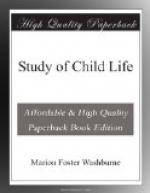(b) Representative and Symbolic Plays. See “Education of Man” (12c) and “Letters to a Mother on the Philosophy of Froebel” (12c). Dancing and Drama from Richter’s “Levana” (12c).
(c) Nature’s Playthings (Earth, Air, Fire, and Water). Ask members of class to describe plays of their own childhood and tell what they meant to them.
(Select answer to test questions on Part II.)
MEETING V
Art and Literature in Child Life. (Study pages 100-112)
Ask members to bring good pictures and story-books, thus making exhibit.
(a) Place of Pictures in Children’s Lives. Of Color. Of Modeling. Influence of artistic surroundings. If anyone knows of a model nursery or schoolroom, let her describe it. Are drawing and modeling at school “fads” or living bases for educational processes? See Dewey on “The School and Society” (10c).
(b) Place of fiction in education. See “The Place of the Story in Early Education” (6c).
(c) Accomplishments. Practical discussion of the advantages and disadvantages of music lessons, the languages, and other work out of school. See “Adolescence,” by G. Stanley Hall.
MEETING VI
Social and Religious Training. (Study pages 114-140 and Supplement)
(a) The Question of Associations. See Dewey’s “The School and Society” (10c), “The Republic of Childhood” (30c). Quote “Up from Slavery” (14c) and “Story of My Life” (14c), to show that the humblest companions may sometimes be the most desirable.
(b) The New Education. See catalogues of the Francis W. Parker School, Chicago, Ill., (4c); The Elementary School, University of Chicago, (6c); State Normal School, Hyannis, Mass., (4c); “School Gardens,” Bulletin No. 160, Office of Experiment Stations, Department of Agriculture, Washington, D.C., (2c).
(c) The Sex Question. Where are the foundations of morality laid—church, school, home, or street? Read entire, “Duties of Parents to Children in Regard to Sex” (pamphlet, 5c).
(d) Religious Training. Read from “Christian Nurture” (12c) and “Psychology of Religion” (14c). (Select answer to test questions on Part III.)
For more extended program, book lists for mothers, children’s book list, loan papers, send to the National Congress of Mothers, Mrs. E.C. Grice, Corresponding Secretary, 3308 Arch Street, Philadelphia, Pa. Price, 10 cents each. See also “The Child in Home, School, and State,” with address by President Roosevelt.—Report of the N.C.M. for 1905. Price, 50c.
NOTE.—When reference books mentioned in the foregoing program are not available from public libraries, they may be borrowed of the A.S.H.E. for the cost of postage indicated in parentheses. Three books may be borrowed at one time by a class, one by an individual. For class work, a book may be kept for two weeks, or longer, if there is no other call for it. Send stamps with requests, which should be made several weeks in advance to avoid disappointment.




